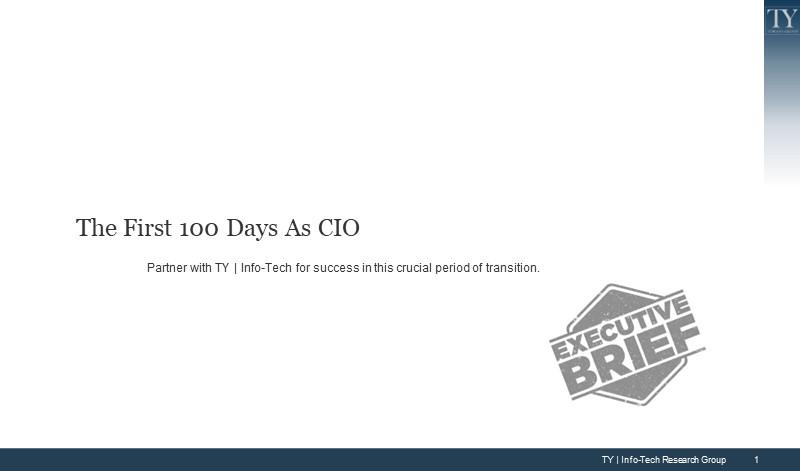
The First 100 Days As CIO
- You’ve been promoted from within to the role of CIO.
- You’ve been hired externally to take on the role of CIO.
Our Advice
Critical Insight
- Foundational understanding must be achieved before you start. Hit the ground running before day one by using company documents and initial discussions to pin down the company’s type and mode.
- Listen before you act (usually). In most situations, executives benefit from listening to peers and staff before taking action.
- Identify quick wins early and often. Fix problems as soon as you recognize them to set the tone for your tenure.
Impact and Result
- Collaborate to collect the details needed to identify the right mode for your organization and determine how it will influence your plan.
- Use Info-Tech’s diagnostic tools to align your vision with that of business executives and form a baseline for future reference.
The First 100 Days As CIO Research & Tools
Start here – read the Executive Brief
Read our concise Executive Brief to find out why the first 100 days of being a new executive is a crucial time that requires the right balance of listening with taking action. See how seven calls with an executive advisor will guide you through this period.Besides the small introduction, subscribers and consulting clients within this management domain have access to:
1. Check in with your executive advisor over seven calls
Organize your first 100 days as CIO into activities completed within two-week periods, aided by the guidance of an executive advisor.
- The First 100 Days As CIO – Storyboard
- Organizational Catalog
- Cultural Archetype Calculator
- IT Capability Assessment
2. Communicate your plan to your manager
Communicate your strategy with a presentation deck that you will complete in collaboration with Info-Tech advisors.
- The First 100 Days As CIO – Presentation Deck
3. View an example of the final presentation
See an example of a completed presentation deck, from the new CIO of Gotham City.
- The First 100 Days As CIO – Presentation Deck Example
4. Listen to our podcast
Check out The Business Leadership podcast in Info-Tech's special series, The First 100 Days.
- "The First 100 Days" Podcast – Alan Fong, CTO, DealerFX
- "The First 100 Days" Podcast – Denis Gaudreault, country manager for Intel’s Canada and Latin America region
- "The First 100 Days" Podcast – Dave Penny & Andrew Wertkin, BlueCat
- "The First 100 Days" Podcast – Susan Bowen, CEO, Aptum
- "The First 100 Days" Podcast – Wayne Berger, CEO IWG Plc Canada and Latin America
- "The First 100 Days" Podcast – Eric Wright, CEO, LexisNexis Canada
- "The First 100 Days" Podcast – Erin Bury, CEO, Willful
Further reading
The First 100 Days As CIO
Partner with Info-Tech for success in this crucial period of transition.
Analyst Perspective
The first 100 days refers to the 10 days before you start and the first three months on the job.
“The original concept of ‘the first 100 days’ was popularized by Franklin Delano Roosevelt, who passed a battery of new legislation after taking office as US president during the Great Depression. Now commonly extended to the business world, the first 100 days of any executive role is a critically important period for both the executive and the organization.
But not every new leader should follow FDR’s example of an action-first approach. Instead, finding the right balance of listening and taking action is the key to success during this transitional period. The type of the organization and the mode that it’s in serves as the fulcrum that determines where the point of perfect balance lies. An executive facing a turnaround situation will want to focus on more action more quickly. One facing a sustaining success situation or a realignment situation will want to spend more time listening before taking action.” (Brian Jackson, Research Director, CIO, Info-Tech Research Group)
Executive summary
Situation
- You’ve been promoted from within to the role of CIO.
- You’ve been hired externally to take on the role of CIO.
Complication
Studies show that two years after a new executive transition, as many as half are regarded as failures or disappointments (McKinsey). First impressions are hard to overcome, and a CIO’s first 100 days are heavily weighted in terms of how others will assess their overall success. The best way to approach this period is determined by both the size and the mode of an organization.
Resolution
- Work with Info-Tech to prepare a 100-day plan that will position you for success.
- Collaborate to collect the details needed to identify the right mode for your organization and determine how it will influence your plan.
- Use Info-Tech’s diagnostic tools to align your vision with that of business executives and form a baseline for future reference.
Info-Tech Insight
- Foundational understanding must be achieved before you start.
Hit the ground running before day one by using company documents and initial discussions to pin down the company’s type and mode. - Listen before you act (usually).
In most situations, executives benefit from listening to peers and staff before taking action. - Identify quick wins early and often.
Fix problems as soon as you recognize them to set the tone for your tenure.
The First 100 Days: Roadmap
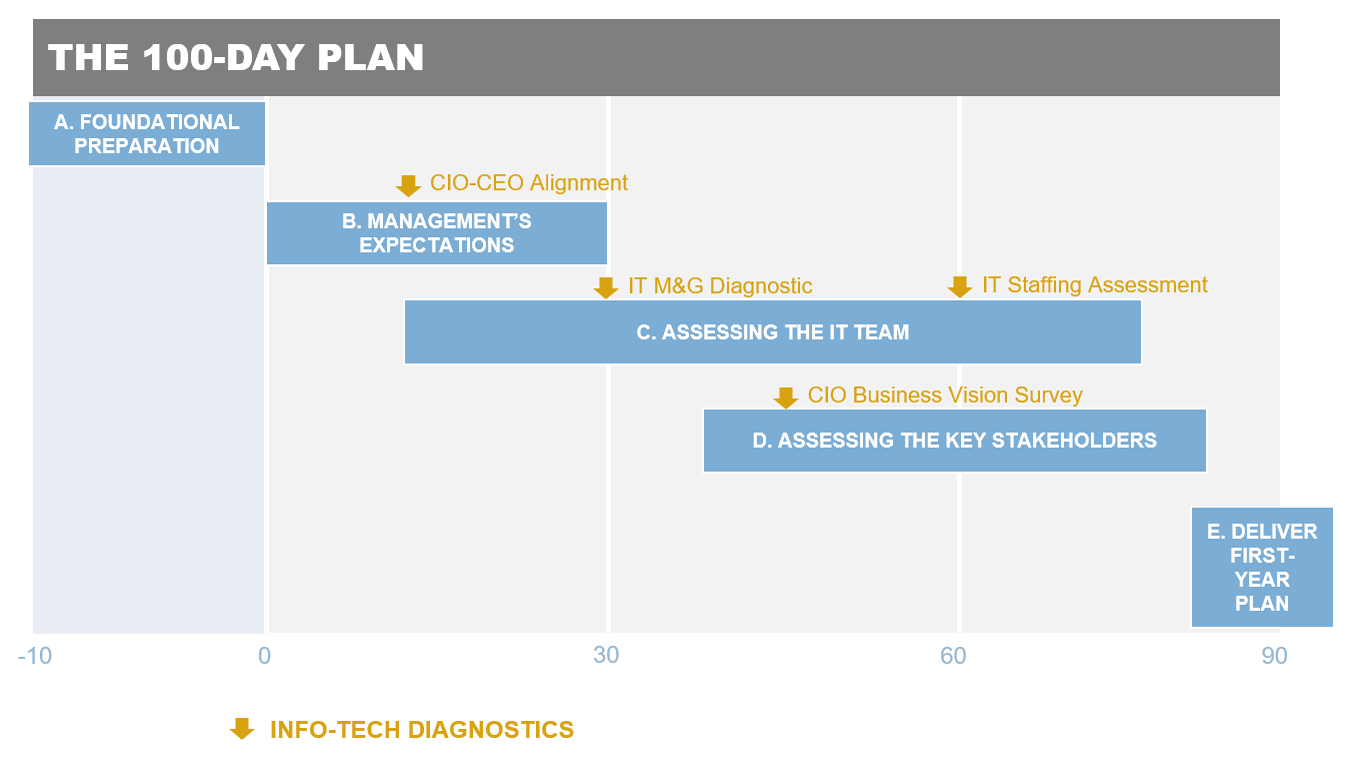
Concierge service overview
Organize a call with your executive advisor every two weeks during your first 100 days. Info-Tech recommends completing our diagnostics during this period. If you’re not able to do so, instead complete the alternative activities marked with (a).
| Call 1 | Call 2 | Call 3 | Call 4 | Call 5 | Call 6 | Call 7 | |
|---|---|---|---|---|---|---|---|
| Activities |
Before you start: Day -10 to Day 1
|
Day 0 to 15
|
Day 16 to 30
|
Day 31 to 45
|
Day 46 to 60
|
Day 61 to 75
|
Day 76 to 90
|
| Deliverables | Presentation Deck Section A: Foundational Preparation | Presentation Deck slides 9, 11-13, 19-20, 29 | Presentation Deck slides 16, 17, 21 | Presentation Deck slides 30, 34 | Presentation Deck slides 24, 25, 2 | Presentation Deck slides 27, 42 |
Call 1
Before you start: Day -10 to Day 1
Interview your predecessor
Interviewing your predecessor can help identify the organization’s mode and type.
Before reaching out to your predecessor, get a sense of whether they were viewed as successful or not. Ask your manager. If the predecessor remains within the organization in a different role, understand your relationship with them and how you'll be working together.
During the interview, make notes about follow-up questions you'll ask others at the organization.
Ask these open-ended questions in the interview:
- Tell me about the team.
- Tell me about your challenges.
- Tell me about a major project your team worked on. How did it go?
- Who/what has been helpful during your tenure?
- Who/what created barriers for you?
- What do your engagement surveys reveal?
- Tell me about your performance management programs and issues.
- What mistakes would you avoid if you could lead again?
- Why are you leaving?
- Could I reach out to you again in the future?
Learn the corporate structure
Identify the organization’s corporate structure type based on your initial conversations with company leadership. The type of structure will dictate how much control you'll have as a functional head and help you understand which stakeholders you'll need to collaborate with.
To Do:
- Review the organization’s structure list and identify whether the structure is functional, prioritized, or a matrix. If it's a matrix organization, determine if it's a strong matrix (project manager holds more authority), weak matrix (functional manager holds more authority), or balanced matrix (managers hold equal authority).
Functional |
|
Projectized |
|
Matrix |
|
This organization is a ___________________ type.
(Source: Simplilearn)Presentation Deck, slide 6
Determine the mode of the organization: STARS
Based on your interview process and discussions with company leadership, and using Michael Watkins’ STARS assessment, determine which mode your organization is in: startup, turnaround, accelerated growth, realignment, or sustaining success.
Knowing the mode of your organization will determine how you approach your 100-day plan. Depending on the mode, you'll rebalance your activities around the three categories of assess, listen, and deliver.
To Do:
- Review the STARS table on the right.
Based on your situation, prioritize activities in this way:
- Startup: assess, listen, deliver
- Turnaround: deliver, listen, assess
- Accelerated Growth: assess, listen, deliver
- Realignment: listen, assess, deliver
- Sustaining success: listen, assess, deliver
This organization is a ___________________ type.
(Source: Watkins, 2013.)
Presentation Deck, slide 6
Determine the mode of the organization: STARS
| STARS | Startup | Turnaround | Accelerated Growth | Realignment | Sustaining Success |
|---|---|---|---|---|---|
| Definition | Assembling capabilities to start a project. | Project is widely seen as being in serious trouble. | Managing a rapidly expanding business. | A previously successful organization is now facing problems. | A vital organization is going to the next level. |
| Challenges | Must build strategy, structures, and systems from scratch. Must recruit and make do with limited resources. | Stakeholders are demoralized; slash and burn required. | Requires structure and systems to scale; hiring and onboarding. | Employees need to be convinced change is needed; restructure at the top required. | Risk of living in shadow of a successful former leader. |
| Advantages | No rigid preconceptions. High-energy environment and easy to pivot. | A little change goes a long way when people recognize the need. | Motivated employee base willing to stretch. | Organization has clear strengths; people desire success. | Likely a strong team; foundation for success likely in place. |
Satya Nadella's listen, lead, and launch approach
CASE STUDY
Industry Software
Source Gregg Keizer, Computerworld, 2014
|
When Satya Nadella was promoted to the CEO role at Microsoft in 2014, he received a Glassdoor approval rating of 85% and was given an "A" grade by industry analysts after his first 100 days. What did he do right?
|
 Satya Nadella, CEO, Microsoft Corp. (Image source: Microsoft) |
Create a one-page introduction sheet to use in communications
As a new CIO, you'll have to introduce yourself to many people in the organization. To save time on communicating who you are as a person outside of the office, create a brief one-pager that includes a photo of you, where you were born and raised, and what your hobbies are. This helps make a connection more quickly so your conversations can focus on the business at hand rather than personal topics.
For your presentation deck, remove the personal details and just keep it professional. The personal aspects can be used as a one-pager for other communications. (Source: Personal interview with Denis Gaudreault, Country Lead, Intel.)
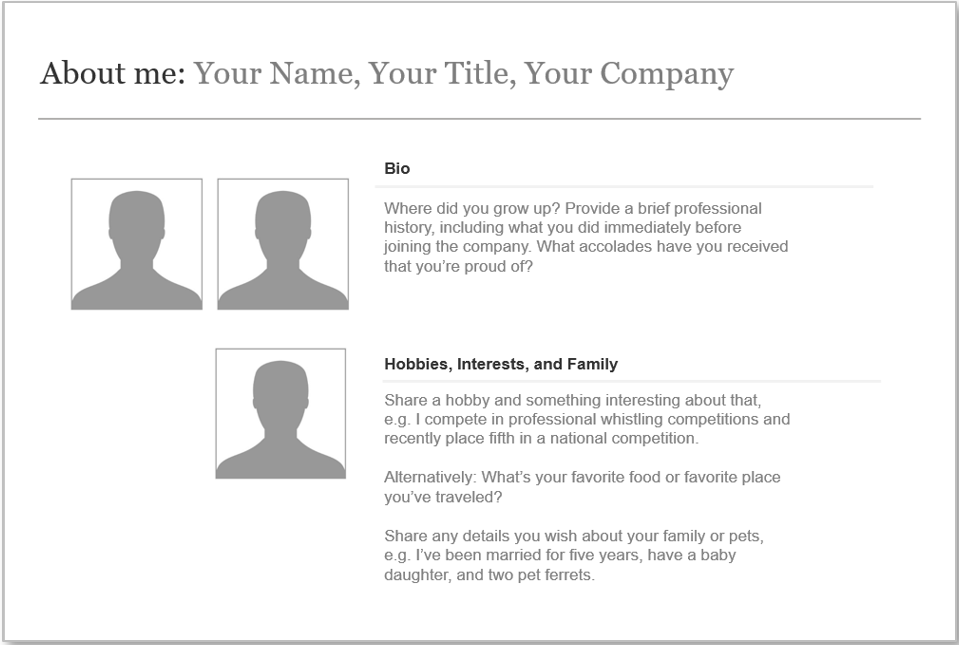
Presentation Deck, slide 5
Call 2
Day 1 to Day 15
Introduce yourself to your team
Prepare a 20-second pitch about yourself that goes beyond your name and title. Touch on your experience that's relevant to your new role or the industry you're in. Be straightforward about your own perceived strengths and weaknesses so that people know what to expect from you. Focus on the value you believe you'll offer the group and use humor and humility where you're comfortable. For example:
“Hi everyone, my name is John Miller. I have 15 years of experience marketing conferences like this one to vendors, colleges, and HR departments. What I’m good at, and the reason I'm here, is getting the right people, businesses, and great ideas in a room together. I'm not good on details; that's why I work with Tim. I promise that I'll get people excited about the conference, and the gifts and talents of everyone else in this room will take over from there. I'm looking forward to working with all of you.”
Have a structured set of questions ready that you can ask everyone.
For example:
- How well is the company performing based on expectations?
- What must the company do to sustain its financial performance and market competitiveness?
- How do you foresee the CIO contributing to the team?
- How have past CIOs performed from the perspective of the team?
- What would successful performance of this role look like to you? To your peers?
- What challenges and obstacles to success am I likely to encounter? What were the common challenges of my predecessor?
- How do you view the culture here and how do successful projects tend to get approved?
- What are your greatest challenges? How could I help you?
Get to know your sphere of influence: prepare to connect with a variety of people before you get down to work
Your ability to learn from others is critical at every stage in your first 100 days. Keep your sphere of influence in the loop as you progress through this period.
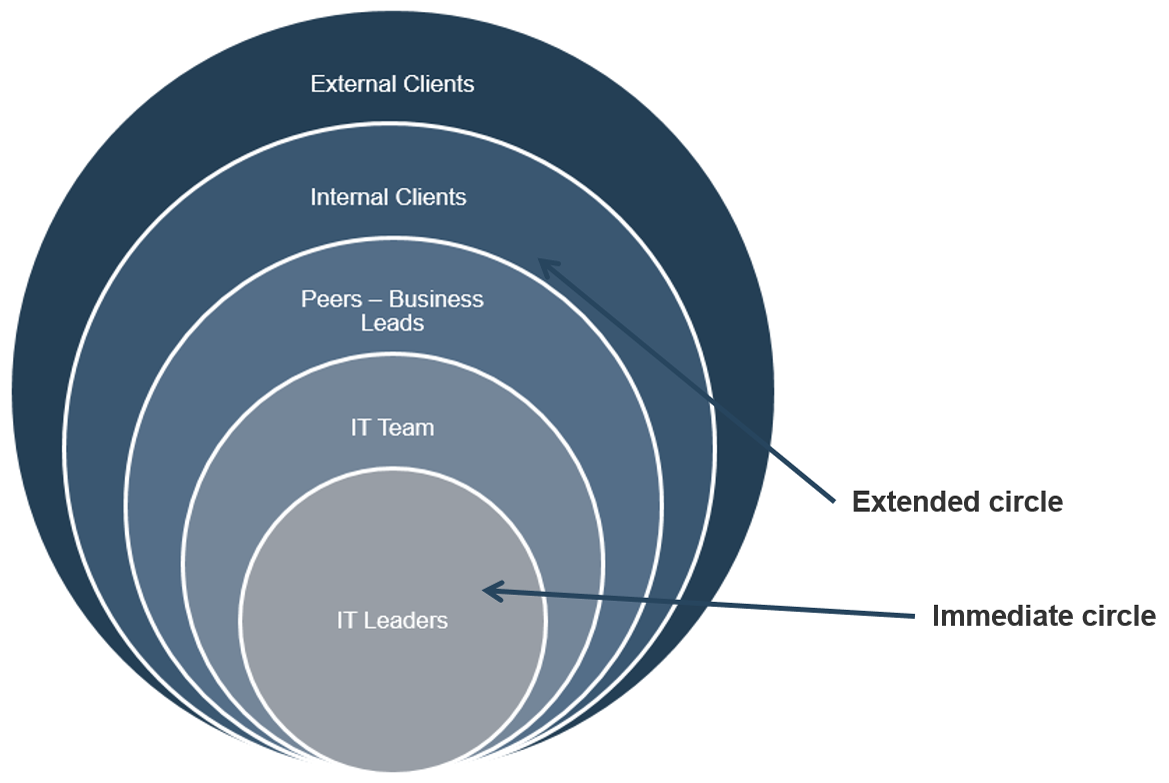
Write down the names, or at least the key people, in each segment of this diagram. This will serve as a quick reference when you're planning communications with others and will help you remember everyone as you're meeting lots of new people in your early days on the job.
- Everyone knows their networks are important.
- However, busy schedules can cause leaders to overlook their many audiences.
- Plan to meet and learn from all people in your sphere to gain a full spectrum of insights.
Presentation Deck, slide 29
Identify how your competitors are leveraging technology for competitive advantage
Competitor identification and analysis are critical steps for any new leader to assess the relative strengths and weaknesses of their organization and develop a sense of strategic opportunity and environmental awareness.
Today’s CIO is accountable for driving innovation through technology. A competitive analysis will provide the foundation for understanding the current industry structure, rivalry within it, and possible competitive advantages for the organization.
Surveying your competitive landscape prior to the first day will allow you to come to the table prepared with insights on how to support the organization and ensure that you are not vulnerable to any competitive blind spots that may exist in the evaluations conducted by the organization already.
You will not be able to gain a nuanced understanding of the internal strengths and weaknesses until you are in the role, so focus on the external opportunities and how competitors are using technology to their advantage.
Info-Tech Best Practice
For a more in-depth approach to identifying and understanding relevant industry trends and turning them into insights, leverage the following Info-Tech blueprints:
Presentation Deck, slide 9
Assess the external competitive environment
INPUT: External research
OUTPUT: Competitor array
- Conduct a broad analysis of the industry as a whole. Seek to answer the following questions:
- Are there market developments or new markets?
- Are there industry or lifestyle trends, e.g. move to mobile?
- Are there geographic changes in the market?
- Are there demographic changes that are shaping decision making?
- Are there changes in market demand?
- Create a competitor array by identifying and listing key competitors. Try to be as broad as possible here and consider not only entrenched close competitors but also distant/future competitors that may disrupt the industry.
- Identify the strengths, weaknesses, and key brand differentiators that each competitor brings to the table. For each strength and differentiator, brainstorm ways that IT-based innovation enables each. These will provide a toolkit for deeper conversations with your peers and your business stakeholders as you move further into your first 100 days.
| Competitor | Strengths | Weaknesses | Key Differentiators | IT Enablers |
|---|---|---|---|---|
| Competitor 1 | ||||
| Competitor 2 | ||||
| Competitor 3 |
Complete the CEO-CIO Alignment Program
INPUT: CEO-CEO Alignment Program (recommended)
OUTPUT: Desired and target state of IT maturity, Innovation goals, Top priorities
Materials: Presentation Deck, slides 11-13
Participants: CEO, CIO
Introduce the concept of the CEO-CIO Alignment Program using slide 10 of your presentation deck and the brief email text below.
Talk to your advisory contact at Info-Tech about launching the program. More information is available on Info-Tech’s website.
Once the report is complete, import the results into your presentation:
- Slide 11, the CEO’s current and desired states
- Slide 12, IT innovation goals
- Slide 13, top projects and top departments from the CEO and the CIO
Include any immediate recommendations you have.
Hello CEO NAME,
I’m excited to get started in my role as CIO, and to hit the ground running, I’d like to make sure that the IT department is aligned with the business leadership. We will accomplish this using Info-Tech Research Group’s CEO-CIO Alignment Program. It’s a simple survey of 20 questions to be completed by the CEO and the CIO.
This survey will help me understand your perception and vision as I get my footing as CIO. I’ll be able to identify and build core IT processes that will automate IT-business alignment going forward and create an effective IT strategy that helps eliminate impediments to business growth.
Research shows that IT departments that are effectively aligned to business goals achieve more success, and I’m determined to make our IT department as successful as possible. I look forward to further detailing the benefits of this program to you and answering any questions you may have the next time we speak.
Regards,
CIO NAME
New KPIs for CEO-CIO Alignment — Recommended
Info-Tech CEO-CIO Alignment Program
Info-Tech's CEO-CIO Alignment Program is set up to build IT-business alignment in any organization. It helps the CIO understand CEO perspectives and priorities. The exercise leads to useful IT performance indicators, clarifies IT’s mandate and which new technologies it should invest in, and maps business goals to IT priorities.
Benefits
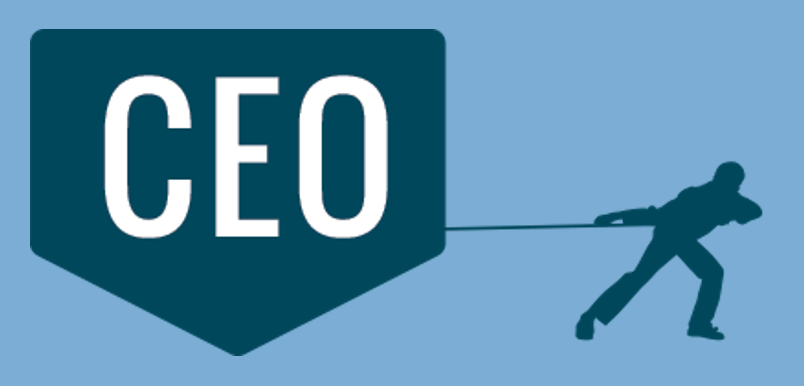
|
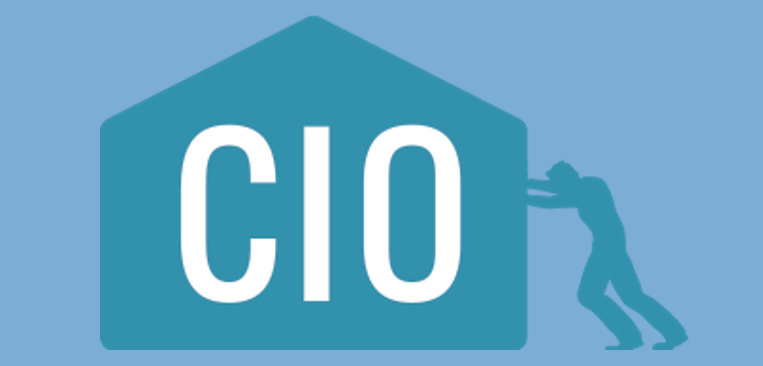
|
|
| Master the Basics
Cut through the jargon. Take a comprehensive look at the CEO perspective. |
Target Alignment
Identify how IT can support top business priorities. Address CEO-CIO differences. |
Start on the Right Path
Get on track with the CIO vision. Use correct indicators and metrics to evaluate IT from day one. |
![]() Additional materials are available on Info-Tech’s website.
Additional materials are available on Info-Tech’s website.
The desired maturity level of IT — Alternative
Step 1: Where are we today?Determine where the CEO sees the current overall maturity level of the IT organization. Step 2: Where do we want to be as an organization?Determine where the CEO wants the IT organization to be in order to effectively support the strategic direction of the business. |
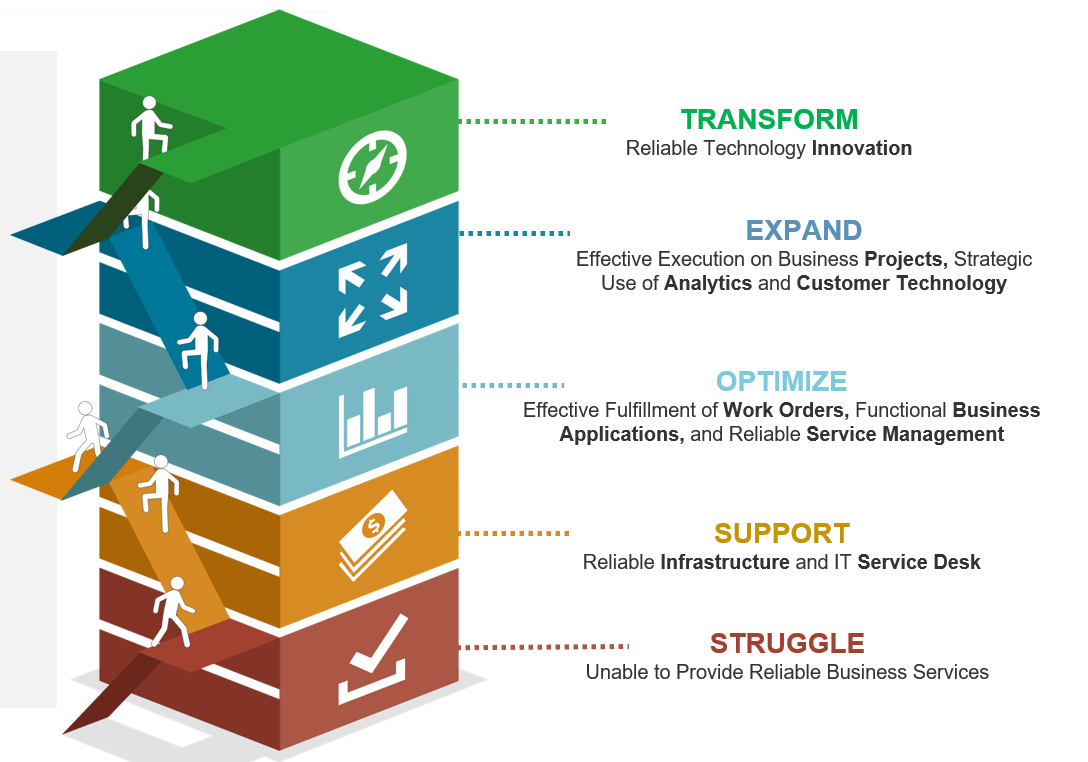
|
Presentation Deck, slide 11
Tim Cook's powerful use of language
CASE STUDY
Industry Consumer technology
Source Carmine Gallo, Inc., 2019
|
Apple CEO Tim Cook, an internal hire, had big shoes to fill after taking over from the late Steve Jobs. Cook's ability to control how the company is perceived is a big credit to his success. How does he do it? His favorite five words are “The way I see it..." These words allow him to take a line of questioning and reframe it into another perspective that he wants to get across. Similarly, he'll often say, "Let me tell you the way I look at it” or "To put it in perspective" or "To put it in context." In your first two weeks on the job, try using these phrases in your conversations with peers and direct reports. It demonstrates that you value their point of view but are independently coming to conclusions about the situation at hand. |
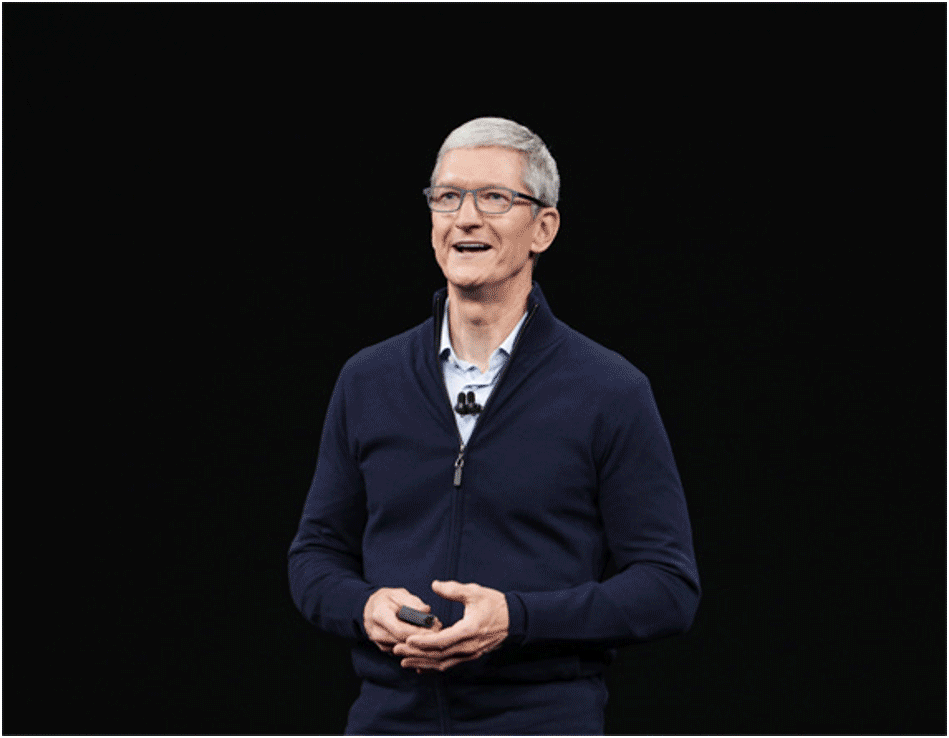 Tim Cook, CEO, Apple Inc. (Image source: Apple) |
Inform your team that you plan to do an IT Management & Governance Diagnostic survey
![]() Run the diagnostic program or use the alternative activities to complete your presentation
Run the diagnostic program or use the alternative activities to complete your presentation
INPUT: IT Management & Governance Diagnostic (recommended)
OUTPUT: Process to improve first, Processes important to the business
Materials: Presentation Deck, slides 19-20
Participants: CIO, IT staff
Introduce the IT Management & Governance Diagnostic survey that will help you form your IT strategy.
Explain that you want to understand current IT capabilities and you feel a formal approach is best. You’ll also be using this approach as an important metric to track your department’s success. Tell them that Info-Tech Research Group will be conducting the survey and it’s important to you that they take action on the email when it’s sent to them.
Example email:
Hello TEAM,
I appreciate meeting each of you, and so far I’m excited about the talents and energy on the team. Now I need to understand the processes and capabilities of our department in a deeper way. I’d like to map our process landscape against an industry-wide standard, then dive deeper into those processes to understand if our team is aligned. This will help us be accountable to the business and plan the year ahead. Advisory firm Info-Tech Research Group will be reaching out to you with a simple survey that shouldn’t take too long to complete. It’s important to me that you pay attention to that message and complete the survey as soon as possible.
Regards,
CIO NAME
Call 3
Day 16 to Day 30
Leverage team interviews as a source of determining organizational culture
Info-Tech recommends that you hold group conversations with your team to uncover their opinions of the current organizational culture. This not only helps build transparency between you and your team but also gives you another means of observing behavior and reactions as you listen to team members’ characterizations of the current culture.
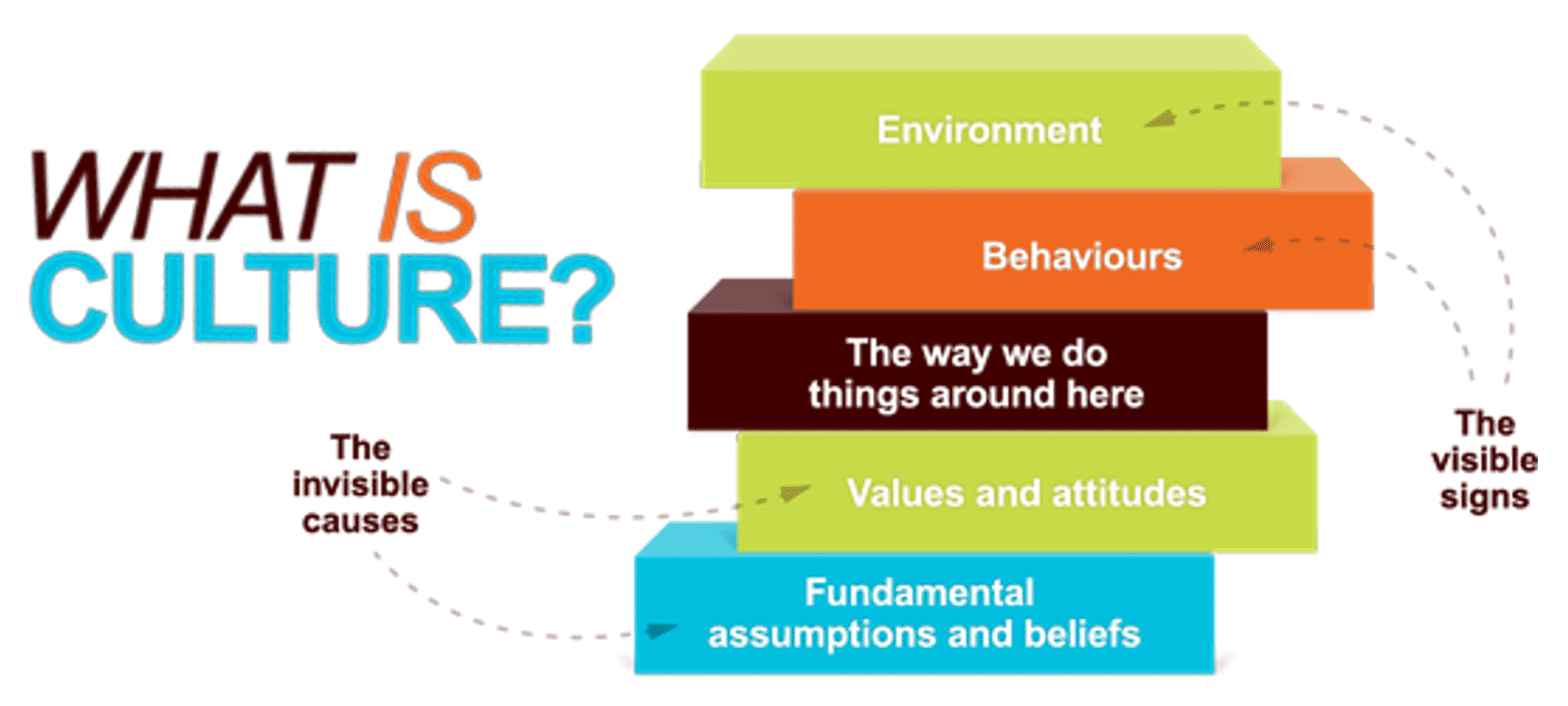 (Source: Hope College Blog Network)
(Source: Hope College Blog Network)
Note: It is inherently difficult for people to verbalize what constitutes a culture – your strategy for extracting this information will require you to ask indirect questions to solicit the highest value information.
Questions for Discussion:
- What about the current organizational environment do you think most contributes to your success?
- What barriers do you experience as you try to accomplish your work?
- What is your favorite quality that is present in our organization?
- What is the one thing you would most like to change about this organization?
- Do the organization's policies and procedures support your efforts to accomplish work or do they impede your progress?
- How effective do you think IT’s interactions are with the larger organization?
- What would you consider to be IT’s top three guiding principles?
- What kinds of people fail in this organization?
![]() See Info-Tech’s Cultural Archetype Calculator.
See Info-Tech’s Cultural Archetype Calculator.
Use the Competing Values Framework to define your organization’s cultural archetype
THE COMPETING VALUES FRAMEWORK (CVF):
|
CVF represents the synthesis of academic study of 39 indicators of effectiveness for organizations. Using a statistical analysis, two polarities that are highly predictive of differences in organizational effectiveness were isolated:
By plotting these dimensions on a matrix of competing values, four main cultural archetypes are identified with their own value drivers and theories of effectiveness. |

|
Presentation Deck, slide 16
Create a cultural adjustment plan
Now that you've assessed the cultural archetype, you can plan an appropriate approach to shape the culture in a positive way. When new executives want to change culture, there are a few main options at hand:
Autonomous evolution: Encourage teams to learn from each other. Empower hybrid teams to collaborate and reward teams that perform well.
Planned and managed change: Create steering committee and project-oriented taskforces to work in parallel. Appoint employees that have cultural traits you'd like to replicate to hold responsibility for these bodies.
Cultural destruction: When a toxic culture needs to be eliminated, get rid of its carriers. Putting new managers or directors in place with the right cultural traits can be a swift and effective way to realign.
Each option boils down to creating the right set of incentives and deterrents. What behaviors will you reward and which ones will you penalize? What do those consequences look like? Sometimes, but not always, some structural changes to the team will be necessary. If you feel these changes should be made, it's important to do it sooner rather than later. (Source: “Enlarging Your Sphere of Influence in Your Organization,” MindTools Corporate, 2014.)
As you're thinking about shaping a desired culture, it's helpful to have an easy way to remember the top qualities you want to espouse. Try creating an acronym that makes it easy for staff to remember. For example: RISE could remind your staff to be Responsive, Innovative, Sustainable, and Engaging (RISE). Draw upon your business direction from your manager to help produce desired qualities (Source: Jennifer Schaeffer).
Presentation Deck, slide 17
Gary Davenport’s welcome “surprise”
CASE STUDY
Industry Telecom
Source Interview with Gary Davenport
|
After Gary Davenport was hired on as VP of IT at MTS Allstream, his first weekend on the job was spent at an all-executive offsite meeting. There, he learned from the CEO that the IT department had a budget reduction target of 25%, like other departments in the company. “That takes your breath away,” Davenport says. He decided to meet the CEO monthly to communicate his plans to reduce spending while trying to satisfy business stakeholders. His top priorities were:
During Davenport’s 7.5-year tenure, the IT department became one of the top performers at MTS Allstream. |
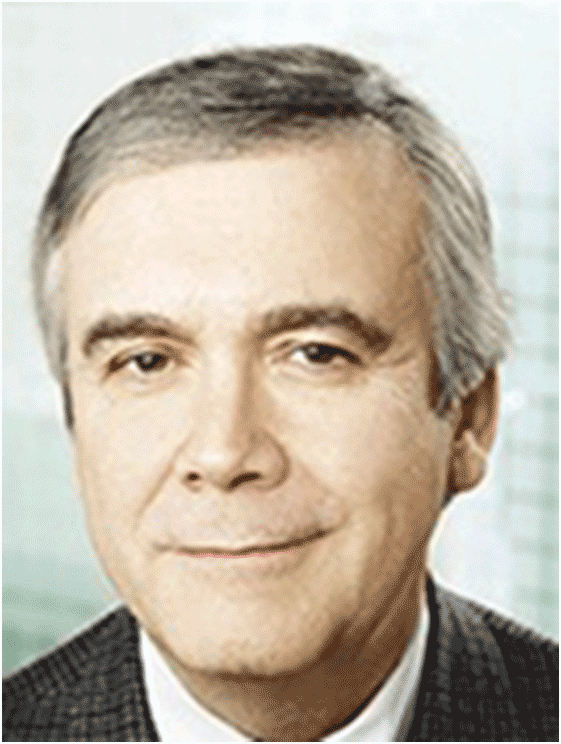 Gary Davenport’s first weekend on the job at MTS Allstream included learning about a 25% reduction target. (Image source: Ryerson University) |
Listen to 'The First 100 Days' podcast – David Penny & Andrew Wertkin
Initiate IT Management & Governance Diagnostic — Recommended
Info-Tech Management & Governance Diagnostic
Talk to your Info-Tech executive advisor about launching the survey shortly after informing your team to expect it. You'll just have to provide the names and email addresses of the staff you want to be involved. Once the survey is complete, you'll harvest materials from it for your presentation deck. See slides 19 and 20 of your deck and follow the instructions on what to include.
Benefits
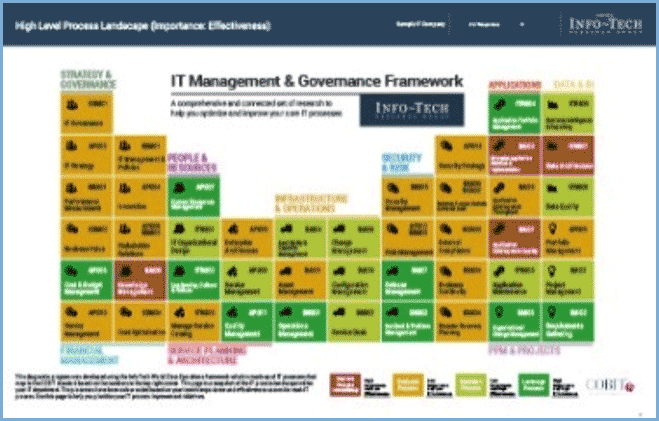
|
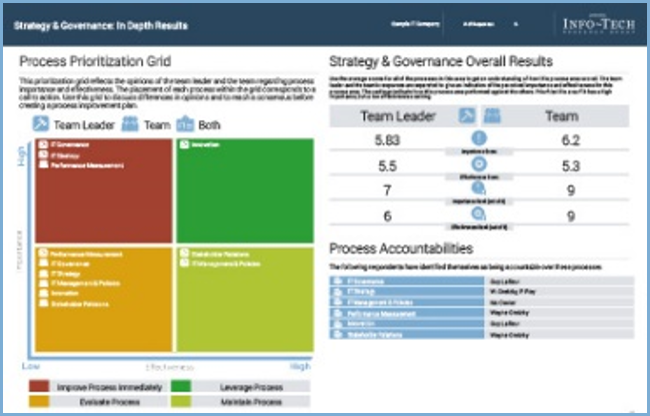
|
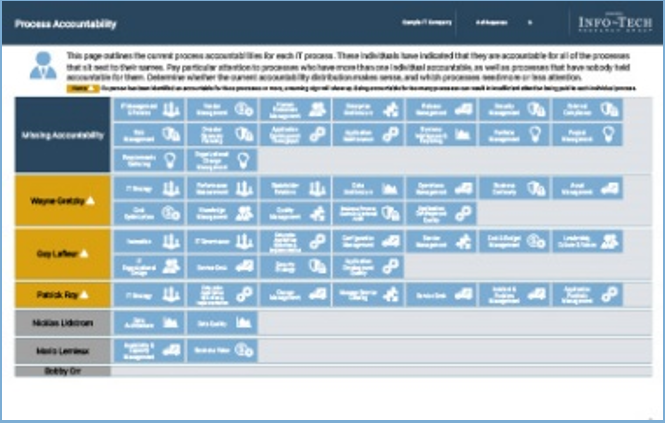
|
| Explore IT Processes
Dive deeper into performance. Highlight problem areas. |
Align IT Team
Build consensus by identifying opposing views. |
Ownership & Accountability
Identify process owners and hold team members accountable. |
![]() Additional materials available on Info-Tech’s website.
Additional materials available on Info-Tech’s website.
Conduct a high-level analysis of current IT capabilities — Alternative
INPUT: Interviews with IT leadership team, Capabilities graphic on next slide
OUTPUT: High-level understanding of current IT capabilities
Run this activity if you're not able to conduct the IT Management & Governance Diagnostic.
Schedule meetings with your IT leadership team. (In smaller organizations, interviewing everyone may be acceptable.) Provide them a list of the core capabilities that IT delivers upon and ask them to rate them on an effectiveness scale of 1-5, with a short rationale for their score.
- 1. Not effective (NE)
- 2. Somewhat Effective (SE)
- 3. Effective (E)
- 4. Very Effective (VE)
- 5. Extremely Effective (EE)
Presentation Deck, slide 21
Use the following set of IT capabilities for your assessment
Strategy & Governance |
IT Governance | Strategy | Performance Measurement | Policies | Quality Management | Innovation | ||
People & Resources |
Stakeholder Management | Resource Management | Financial Management | Vendor Selection & Contract Management | Vendor Portfolio Management | Workforce Strategy | Strategic Comm. | Organizational Change Enablement |
Service Management & Operations |
Operations Management | Service Portfolio Management | Release Management | Service Desk | Incident & Problem Management | Change Management | Demand Management | |
Infrastructure |
Asset Management | Infrastructure Portfolio Management | Availability & Capacity Management | Infrastructure Management | Configuration Management | |||
Information Security & Risk |
Security Strategy | Risk Management | Compliance, Audit & Review | Security Detection | Response & Recovery | Security Prevention | ||
Applications |
Application Lifecycle Management | Systems Integration | Application Development | User Testing | Quality Assurance | Application Maintenance | ||
PPM & Projects |
Portfolio Management | Requirements Gathering | Project Management | |||||
Data & BI |
Data Architecture | BI & Reporting | Data Quality & Governance | Database Operations | Enterprise Content Management | |||
Enterprise Architecture |
Enterprise Architecture | Solution Architecture |
Quick wins: CEO-CIO Alignment Program
Complete this while waiting on the IT M&G survey results. Based on your completed CEO-CIO Alignment Report, identify the initiatives you can tackle immediately.
| If you are here... | And want to be here... | Drive toward... | Innovate around... | 
|
|---|---|---|---|---|
| Business Partner | Innovator | Leading business transformation |
|
|
| Trusted Operator | Business Partner | Optimizing business process and supporting business transformation |
|
|
| Firefighter | Trusted Operator | Optimize IT processes and services |
|
|
| Unstable | Firefighter | Reduce use disruption and adequately support the business |
|
Call 4
Day 31 to Day 45
Inform your peers that you plan to do a CIO Business Vision survey to gauge your stakeholders’ satisfaction
![]() Run the diagnostic program or use the alternative activities to complete your presentation
Run the diagnostic program or use the alternative activities to complete your presentation
INPUT: CIO Business Vision survey (recommended)
OUTPUT: True measure of business satisfaction with IT
Materials: Presentation Deck, slide 30
Participants: CIO, IT staff
Meet the business leaders at your organization face-to-face if possible. If you can't meet in person, try a video conference to establish some rapport. At the end of your introduction and after listening to what your colleague has to say, introduce the CIO Business Vision Diagnostic.
Explain that you want to understand how to meet their business needs and you feel a formal approach is best. You'll also be using this approach as an important metric to track your department's success. Tell them that Info-Tech Research Group will be conducting the survey and it’s important to you that they take the survey when the email is sent to them.
Example email:
Hello PEER NAMES,
I'm arranging for Info-Tech Research Group to invite you to take a survey that will be important to me. The CIO Business Vision survey will help me understand how to meet your business needs. It will only take about 15 minutes of your time, and the top-line results will be shared with the organization. We will use the results to plan initiatives for the future that will improve your satisfaction with IT.
Regards,
CIO NAME
Gain feedback on your initial assessments from your IT team
There are two strategies for gaining feedback on your initial assessments of the organization from the IT team:
- Review your personal assessments with the relevant members of your IT organization as a group. This strategy can help to build trust and an open channel for communication between yourself and your team; however, it also runs the risk of being impacted by groupthink.
- Ask for your team to complete their own assessments for you to compare and contrast. This strategy can help extract more candor from your team, as they are not expected to communicate what may be nuanced perceptions of organizational weaknesses or criticisms of the way certain capabilities function.
Who you involve in this process will be impacted by the size of your organization. For larger organizations, involve everyone down to the manager level. In smaller organizations, you may want to involve everyone on the IT team to get an accurate lay of the land.
Areas for Review:
- Strategic Document Review: Are there any major themes or areas of interest that were not covered in my initial assessment?
- Competitor Array: Are there any initiatives in flight to leverage new technologies?
- Current State of IT Maturity: Does IT’s perception align with the CEO’s? Where do you believe IT has been most effective? Least effective?
- IT’s Key Priorities: Does IT’s perception align with the CEO’s?
- Key Performance Indicators: How has IT been measured in the past?
Info-Tech Best Practice
You need your team’s hearts and minds or you risk a short tenure. Overemphasizing business commitment by neglecting to address your IT team until after you meet your business stakeholders will result in a disenfranchised group. Show your team their importance.
Susan Bowen's talent maximization
CASE STUDY
Industry Infrastructure Services
Source Interview with Susan Bowen
|
Susan Bowen was promoted to be the president of Cogeco Peer 1, an infrastructure services firm, when it was still a part of Cogeco Communications. Part of her mandate was to help spin out the business to a new owner, which occurred when it was acquired by Digital Colony. The firm was renamed Aptum and Bowen was put in place as CEO, which was not a certainty despite her position as president at Cogeco Peer 1. She credits her ability to put the right talent in the right place as part of the reason she succeeded. After becoming president, she sought a strong commitment from her directors. She gave them a choice about whether they'd deliver on a new set of expectations – or not. She also asks her leadership on a regular basis if they are using their talent in the right way. While it's tempting for directors to want to hold on to their best employees, those people might be able to enable many more people if they can be put in another place. Bowen fully rounded out her leadership team after Aptum was formed. She created a chief operating officer and a chief infrastructure officer. This helped put in place more clarity around roles at the firm and put an emphasis on client-facing services. |
 Susan Bowen, CEO, Aptum (Image source: Aptum) |
Initiate CIO Business Vision survey – new KPIs for stakeholder management — Recommended
Info-Tech CIO Business Vision
Be sure to effectively communicate the context of this survey to your business stakeholders before you launch it. Plan to talk about your plans to introduce it in your first meetings with stakeholders. When ready, let your executive advisor know you want to launch the tool and provide the names and email addresses of the stakeholders you want involved. After you have the results, harvest the materials required for your presentation deck. See slide 30 and follow the instructions on what to include.
Benefits

|

|

|

|
| Key Stakeholders
Clarify the needs of the business. |
Credibility
Create transparency. |
Improve
Measure IT’s progress. |
Focus
Find what’s important. |
![]() Additional materials are available on Info-Tech’s website.
Additional materials are available on Info-Tech’s website.
Create a catalog of key stakeholder details to reference prior to future conversations — Alternative
Only conduct this activity if you’re not able to run the CIO Business Vision diagnostic.
Use the Organizational Catalog as a personal cheat sheet to document the key details around each of your stakeholders, including your CEO when possible.
The catalog will be an invaluable tool to keep the competing needs of your different stakeholders in line, while ensuring you are retaining the information to build the political capital needed to excel in the C-suite.
Note: It is important to keep this document private. While you may want to communicate components of this information, ensure your catalog remains under lock and (encryption) key.
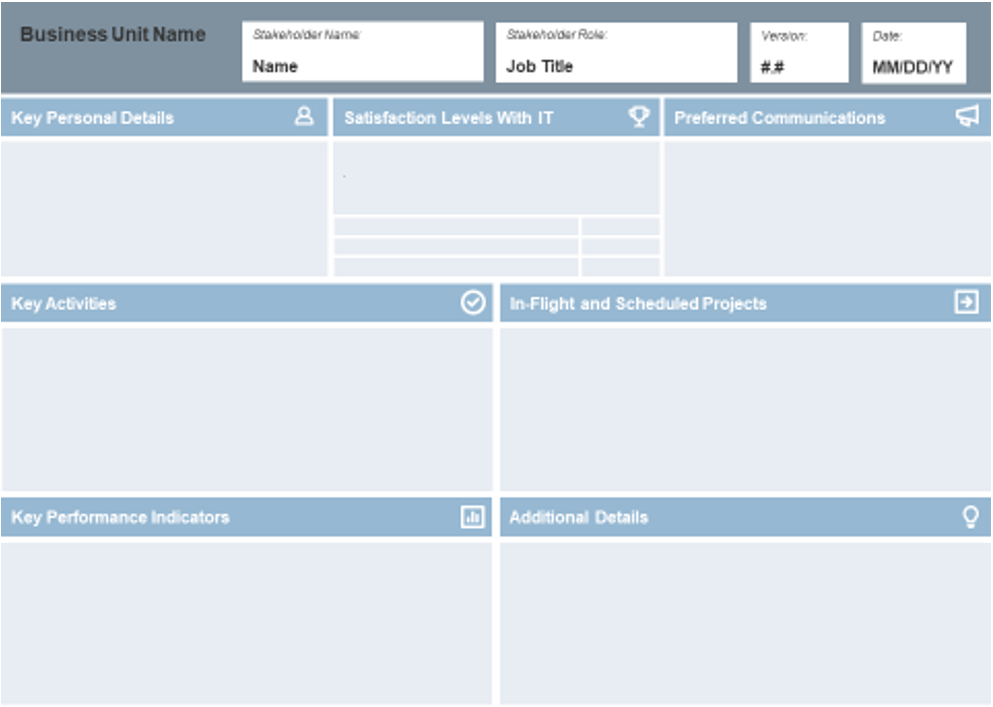
Info-Tech Insight
While profiling your stakeholders is important, do not be afraid to profile yourself as well. Visualizing how your interests overlap with those of your stakeholders can provide critical information on how to manage your communications so that those on the receiving end are hearing exactly what they need.
Activity: Conduct interviews with your key business stakeholders — Alternative
![]()
- Once you have identified your key stakeholders through your interviews with your boss and your IT team, schedule a set of meetings with those individuals.
- Use the meetings to get to know your stakeholders, their key priorities and initiatives, and their perceptions of the effectiveness of IT.
- Use the probative questions to the right to elicit key pieces of information.
- Refer to the Organizational Catalog tool for more questions to dig deeper in each category. Ensure that you are taking notes separate from the tool and are keeping the tool itself secure, as it will contain private information specific to your interests.
- Following each meeting, record the results of your conversation and any key insights in the Organizational Catalog. Refer to the following slide for more details.
Questions for Discussion:
- Be indirect about your personal questions – share stories that will elicit details about their interests, kids, etc.
- What are your most critical/important initiatives for the year?
- What are your key revenue streams, products, and services?
- What are the most important ways that IT supports your success? What is your satisfaction level with those services?
- Are there any current in-flight projects or initiatives that are a current pain point? How can IT assist to alleviate challenges?
- How is your success measured? What are your targets for the year on those metrics?
Presentation Deck, slide 34
Call 5
Day 46 to Day 60
Inform your team that you plan to do an IT staffing assessment
![]() Introduce the IT Staffing Assessment that will help you get the most out of your team
Introduce the IT Staffing Assessment that will help you get the most out of your team
INPUT: Email template
OUTPUT: Ready to launch diagnostic
Materials: Email template, List of staff, Sample of diagnostic
Participants: CIO, IT staff
Explain that you want to understand how the IT staff is currently spending its time by function and by activity. You want to take a formal approach to this task and also assess the team’s feelings about its effectiveness across different processes. The results of the assessment will serve as the foundation that helps you improve your team’s effectiveness within the organization.
Example email:
Hello PEER NAMES,
The feedback I've heard from the team since joining the company has been incredibly useful in beginning to formulate my IT strategy. Now I want to get a clear picture of how everyone is spending their time, especially across different IT functions and activities. This will be an opportunity for you to share feedback on what we're doing well, what we need to do more of, and what we're missing. Expect to receive an email invitation to take this survey from Info-Tech Research Group. It's important to me that you complete the survey as soon as you're can. Attached you’ll find an example of the report this will generate. Thank you again for providing your time and feedback.
Regards,
CIO NAME
Wayne Berger's shortcut to solve staffing woes
CASE STUDY
Industry Office leasing
Source Interview with Wayne Berger
|
Wayne Berger was hired to be the International Workplace Group (IWG) CEO for Canada and Latin America in 2014. Wayne approached his early days with the office space leasing firm as a tour of sorts, visiting nearly every one of the 48 office locations across Canada to host town hall meetings. He heard from staff at every location that they felt understaffed. But instead of simply hiring more staff, Berger actually reduced the workforce by 33%. He created a more flexible approach to staffing:
|
 Wayne Berger, CEO, IWG Plc (Image source: IWG) |
Initiate IT Staffing Assessment – new KPIs to track IT performance — Recommended
Info-Tech IT Staffing Assessment
Info-Tech’s IT Staffing Assessment provides benchmarking of key metrics against 4,000 other organizations. Dashboard-style reports provide key metrics at a glance, including a time breakdown by IT function and by activity compared against business priorities. Run this survey at about the 45-day mark of your first 90 days. Its insights will be used to inform your long-term IT strategy.
Benefits

|

|

|
| Right-Size IT Headcount
Find the right level for stakeholder satisfaction. |
Allocate Staff Correctly
Identify staff misalignments with priorities. |
Maximize Teams
Identify how to drive staff. |
![]() Additional materials are available on Info-Tech’s website.
Additional materials are available on Info-Tech’s website.
Quick wins: Make recommendations based on IT Management & Governance Framework
Complete this exercise while waiting on the IT Staffing Assessment results. Based on your completed IT Management & Governance report, identify the initiatives you can tackle immediately. You can conduct this as a team exercise by following these steps:
- Create a shortlist of initiatives based on the processes that were identified as high need but scored low in effectiveness. Think as broadly as possible during this initial brainstorming.
- Write each initiative on a sticky note and conduct a high-level analysis of the amount of effort that would be required to complete it, as well as its alignment with the achievement of business objectives.
- Draw the matrix below on a whiteboard and place each sticky note onto the matrix based on its potential impact and difficulty to address.
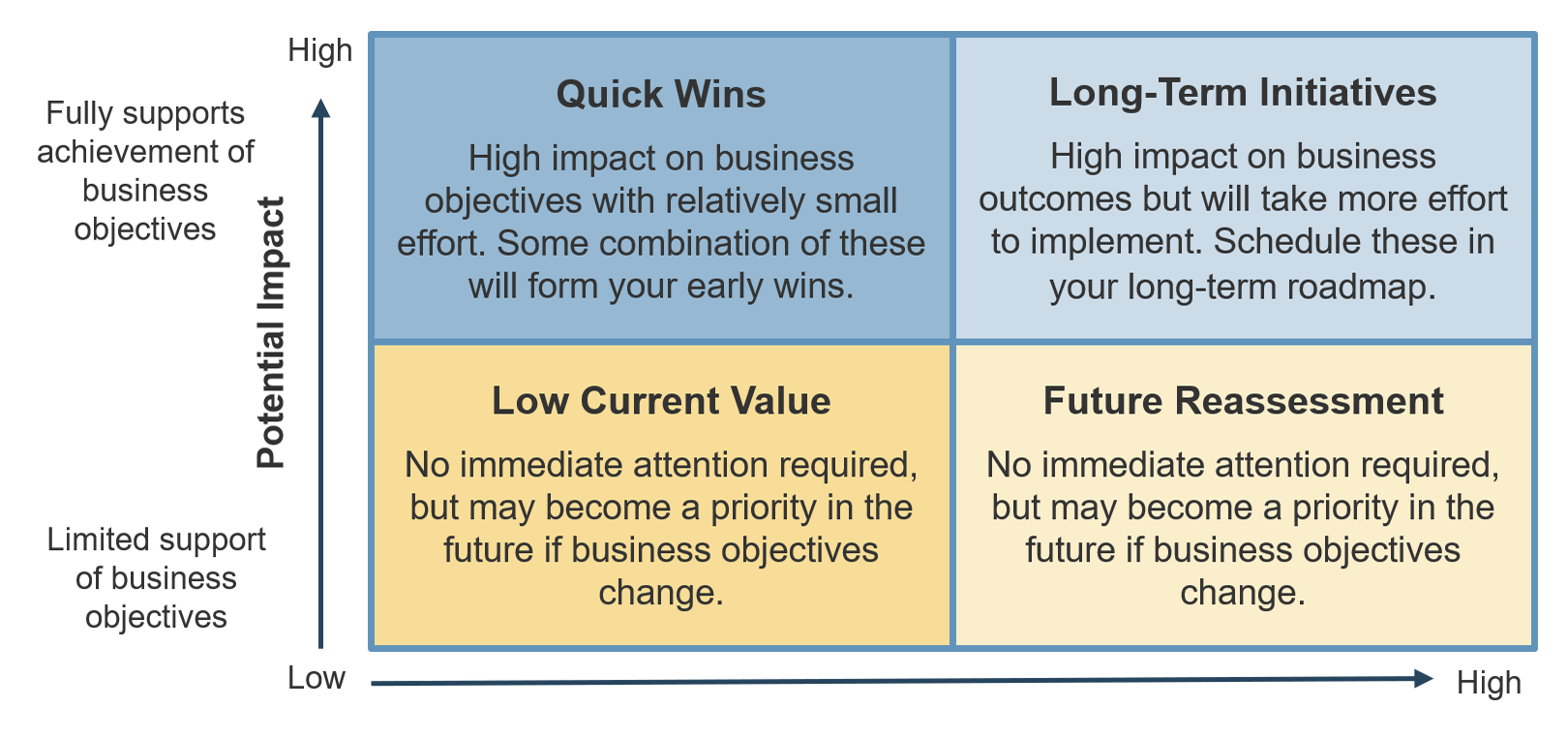
Call 6
Day 61 to Day 75
Run a start, stop, continue exercise with your IT staff — Alternative
This is an alternative activity to running an IT Staffing Assessment, which contains a start/stop/continue assessment. This activity can be facilitated with a flip chart or a whiteboard. Create three pages or three columns and label them Start, Stop, and Continue.
Hand out sticky notes to each team member and then allow time for individual brainstorming. Instruct them to write down their contributions for each category on the sticky notes. After a few minutes, have everyone stick their notes in the appropriate category on the board. Discuss as a group and see what themes emerge. Record the results that you want to share in your presentation deck (GroupMap).
Gather your team and explain the meaning of these categories:
Start: Activities you're not currently doing but should start doing very soon.
Stop: Activities you're currently doing but aren’t working and should cease.
Continue: Things you're currently doing and are working well.
Presentation Deck, slide 24
Determine the alignment of IT commitments with business objectives
INPUT: Interviews with IT leadership team
OUTPUT: High-level understanding of in-flight commitments and investments
Run this only as an alternative to the IT Management & Governance Diagnostic.
- Schedule meetings with IT leadership to understand what commitments have been made to the business in terms of new products, projects, or enhancements.
- Determine the following about IT’s current investment mix:
- What are the current IT investments and assets? How do they align to business goals?
- What investments in flight are related to which information assets?
- Are there any immediate risks identified for these key investments?
- What are the primary business issues that demand attention from IT consistently?
- What choices remain undecided in terms of strategic direction of the IT organization?
- Document your key investments and commitments as well as any points of misalignment between objectives and current commitments as action items to address in your long-term plans. If they are small fixes, consider them during your quick-win identification.
Presentation Deck, slide 25
Determine the alignment of IT commitments with business objectives
Run this only as an alternative to the IT Staffing Assessment diagnostic.
Schedule meetings with IT leadership to understand what commitments have been made to the business in terms of new products, projects, or enhancements.
Determine the following about IT’s current investment mix:
- What are the current IT investments and assets?
- How do they align to business goals?
- What in-flight investments are related to which information assets?
- Are there any immediate risks identified for these key investments?
- What are the primary business issues that demand attention from IT consistently?
- What remains undecided in terms of strategic direction of the IT organization?
Document your key investments and commitments, as well as any points of misalignment between objectives and current commitments, as action items to address in your long-term plans. If they are small-effort fixes, consider them during your quick-win identification.
Presentation Deck, slide 25
Make a categorized vendor list by IT process
As part of learning the IT team, you should also create a comprehensive list of vendors under contract. Collaborate with the finance department to get a clear view of how much of the IT budget is spent on specific vendors. Try to match vendors to the IT processes they serve from the IT M&G framework.
You should also organize your vendors based on their budget allocation. Go beyond just listing how much money you’re spending with each vendor and categorize them into either “transactional” relationships or “strategic relationships.” Use the grid below to organize them. Ideally, you’ll want most relationships to be high spend and strategic (Source: Gary Davenport).
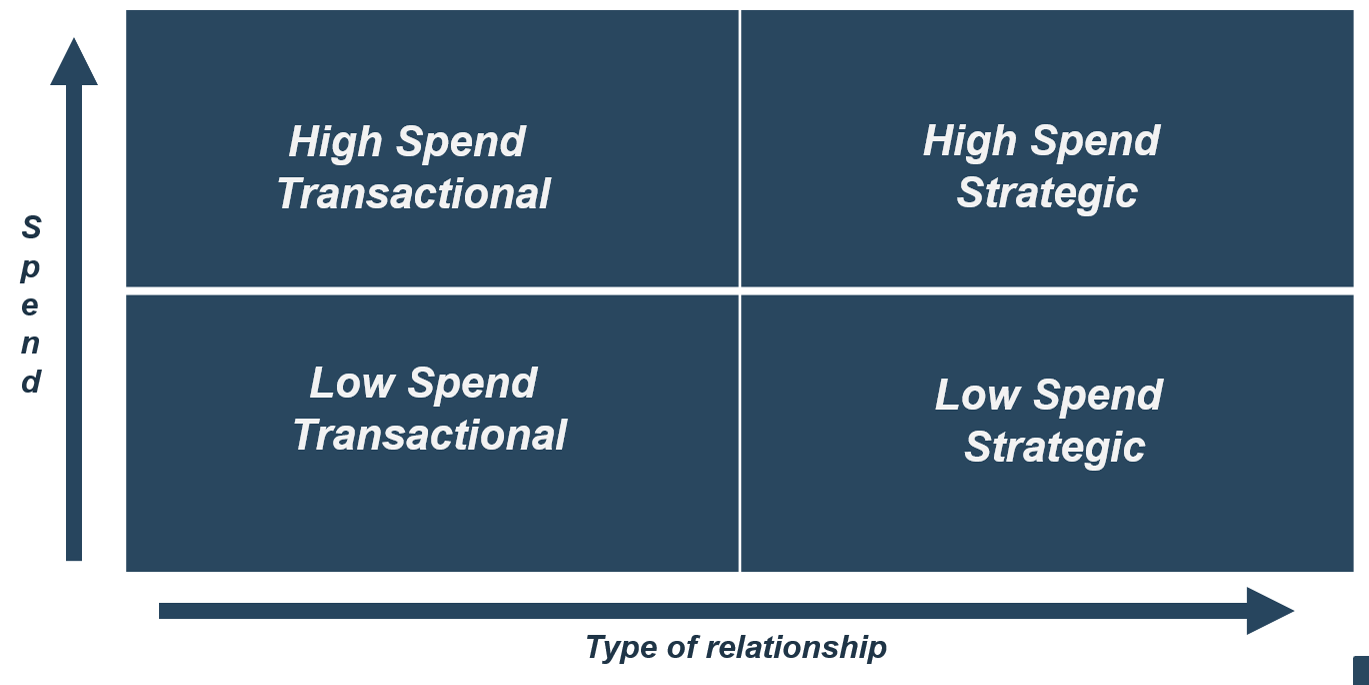
Where to source your vendor list:
- Finance department
- Infrastructure managers
- Vendor manager in IT
Further reading: Manage Your Vendors Before They Manage You
Presentation Deck, slide 26
Jennifer Schaeffer’s short-timeline turnaround
CASE STUDY
Industry Education
Source Interview with Jennifer Schaeffer
|
Jennifer Schaeffer joined Athabasca University as CIO in November 2017. She was entering a turnaround situation as the all-online university lacked an IT strategy and had built up significant technical debt. Armed with the mandate of a third-party consultant that was supported by the president, Schaeffer used a people-first approach to construct her strategy. She met with all her staff, listening to them carefully regardless of role, and consulted with the administrative council and faculty members. She reflected that feedback in her plan or explained to staff why it wasn’t relevant for the strategy. She implemented a “strategic calendaring” approach for the organization, making sure that her team members were participating in meetings where their work was assessed and valued. Drawing on Spotify as an inspiration, she designed her teams in a way that everyone was connected to the customer experience. Given her short timeline to execute, she put off a deep skills analysis of her team for a later time, as well as creating a full architectural map of her technology stack. The outcome is that 2.5 years later, the IT department is unified in using the same tooling and optimization standards. It’s more flexible and ready to incorporate government changes, such as offering more accessibility options. |
 Jennifer Schaeffer took on the CIO role at Athabasca University in 2017 and was asked to create a five-year strategic plan in just six weeks. (Image source: Athabasca University) |
Call 7
Day 76 to Day 90
Finalize your vision – mission – values statement
A clear statement for your values, vision, and mission will help crystallize your IT strategy and communicate what you're trying to accomplish to the entire organization.
Mission: This statement describes the needs that IT was created to meet and answers the basic question of why IT exists.
Vision: Write a statement that captures your values. Remember that the vision statement sets out what the IT organization wants to be known for now and into the future.
Values: IT core values represent the standard axioms by which the IT department operates. Similar to the core values of the organization as a whole, IT’s core values are the set of beliefs or philosophies that guide its strategic actions.
Further reading: IT Vision and Mission Statements Template
Presentation Deck, slide 42
John Chen's new strategic vision
CASE STUDY
Industry Mobile Services
Source Sean Silcoff, The Globe and Mail
|
John Chen, known in the industry as a successful turnaround executive, was appointed BlackBerry CEO in 2014 following the unsuccessful launch of the BlackBerry 10 mobile operating system and a new tablet. He spent his first three months travelling, talking to customers and suppliers, and understanding the company's situation. He assessed that it had a problem generating cash and had made some strategic errors, but there were many assets that could benefit from more investment. He was blunt about the state of BlackBerry, making cutting observations of the past mistakes of leadership. He also settled a key question about whether BlackBerry would focus on consumer or enterprise customers. He pointed to a base of 80,000 enterprise customers that accounted for 80% of revenue and chose to focus on that. His new mission for BlackBerry: to transform it from being a "mobile technology company" that pushes handset sales to "a mobile solutions company" that serves the mobile computing needs of its customers. |
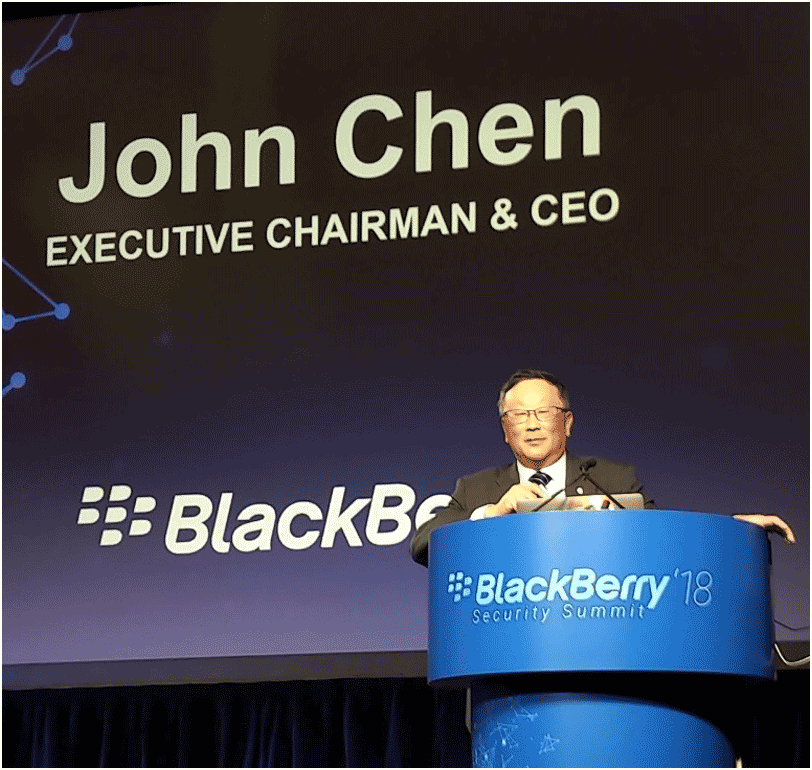 John Chen, CEO of BlackBerry, presents at BlackBerry Security Summit 2018 in New York City (Image source: Brian Jackson) |
Quick wins: Make recommendations based on the CIO Business Vision survey
Based on your completed CIO Business Vision survey, use the IT Satisfaction Scorecard to determine some initiatives. Focus on areas that are ranked as high importance to the business but low satisfaction. While all of the initiatives may be achievable given enough time, use the matrix below to identify the quick wins that you can focus on immediately. It’s important to not fail in your quick-win initiative.
- High Visibility, Low Risk: Best bet for demonstrating your ability to deliver value.
- Low Visibility, Low Risk: Worth consideration, depending on the level of effort required and the relative importance to the stakeholder.
- High Visibility, High Risk: Limit higher-risk initiatives until you feel you have gained trust from your stakeholders, demonstrating your ability to deliver.
- Low Visibility, High Risk: These will be your lowest value, quick-win initiatives. Keep them in a backlog for future consideration in case business objectives change.
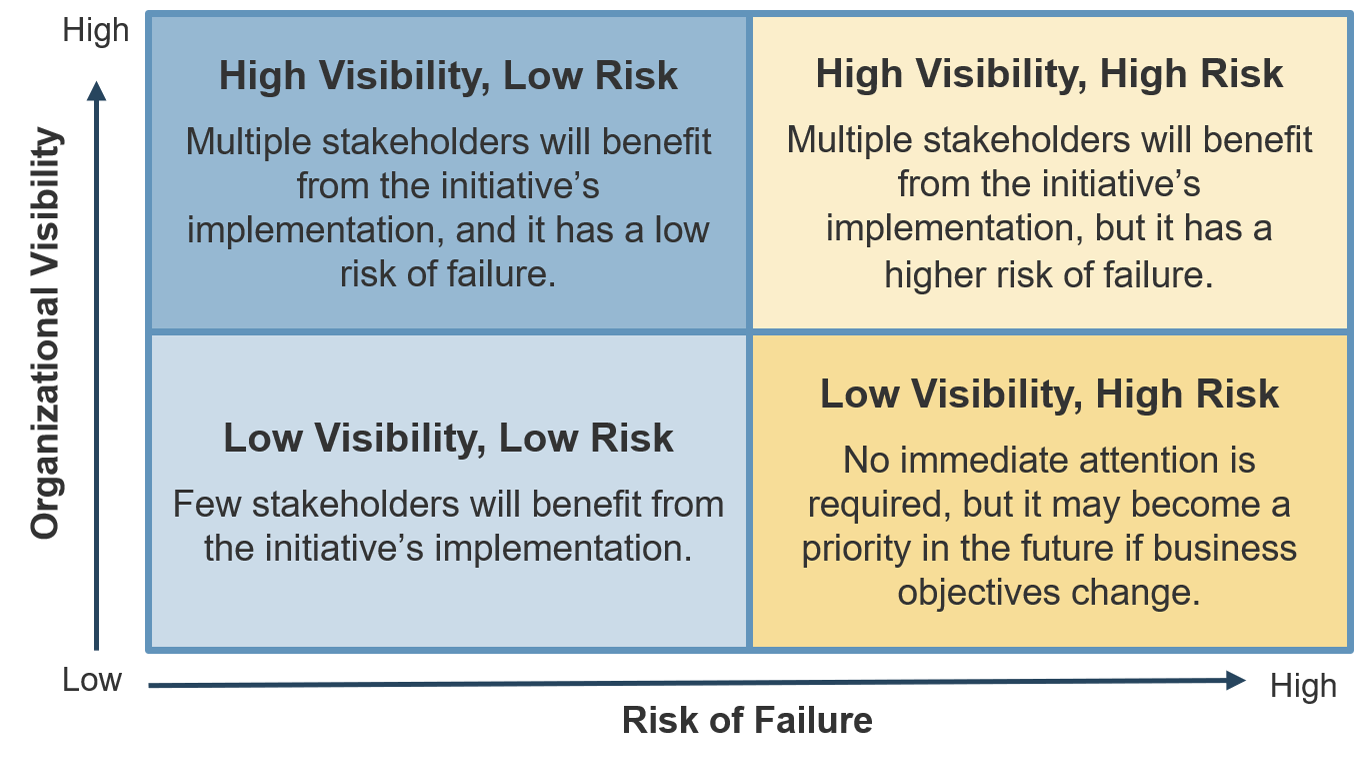
Presentation Deck, slide 27
Create and communicate a post-100 plan
The last few slides of your presentation deck represent a roundup of all the assessments you’ve done and communicate your plan for the months ahead.
Slide 38. Based on the information on the previous slide and now knowing which IT capabilities need improvement and which business priorities are important to support, estimate where you'd like to see IT staff spend their time in the near future. Will you be looking to shift staff from one area to another? Will you be looking to hire staff?
Slide 39. Take your IT M&G initiatives from slide 19 and list them here. If you've already achieved a quick win, list it and mark it as completed to show what you've accomplished. Briefly outline the objectives, how you plan to achieve the result, and what measurement will indicate success.
Slide 40. Reflect your CIO Business Vision initiatives from slide 31 here.
Slide 41. Use this roadmap template to list your initiatives by roughly when they’ll be worked on and completed. Plan for when you’ll update your diagnostics.
Expert Contributors

|
Alan Fong, Chief Technology Officer, Dealer-FX |
 
|
Andrew Wertkin, Chief Strategy Officer, BlueCat Networks
David Penny, Chief Technology Officer, BlueCat Networks |
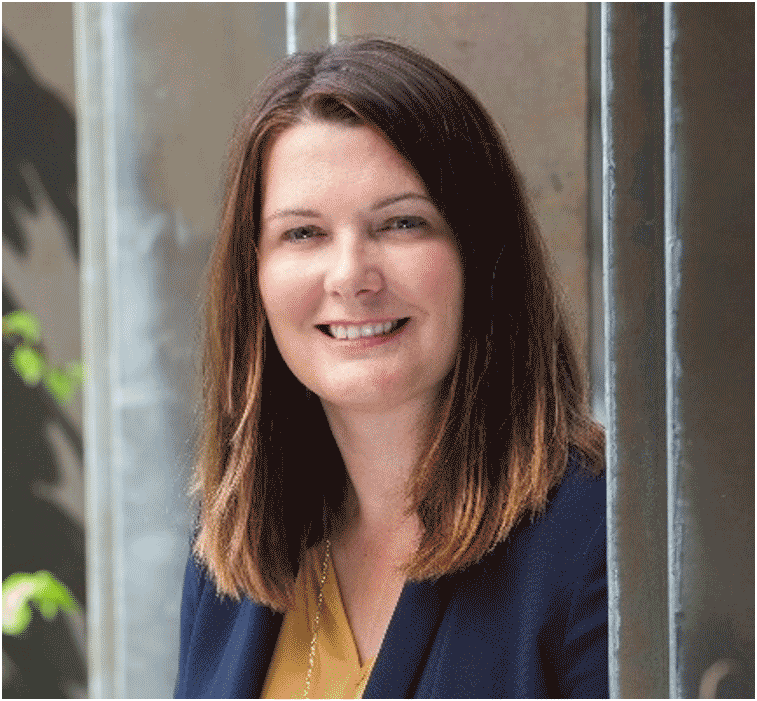
|
Susan Bowen, CEO, Aptum |

|
Erin Bury, CEO, Willful |
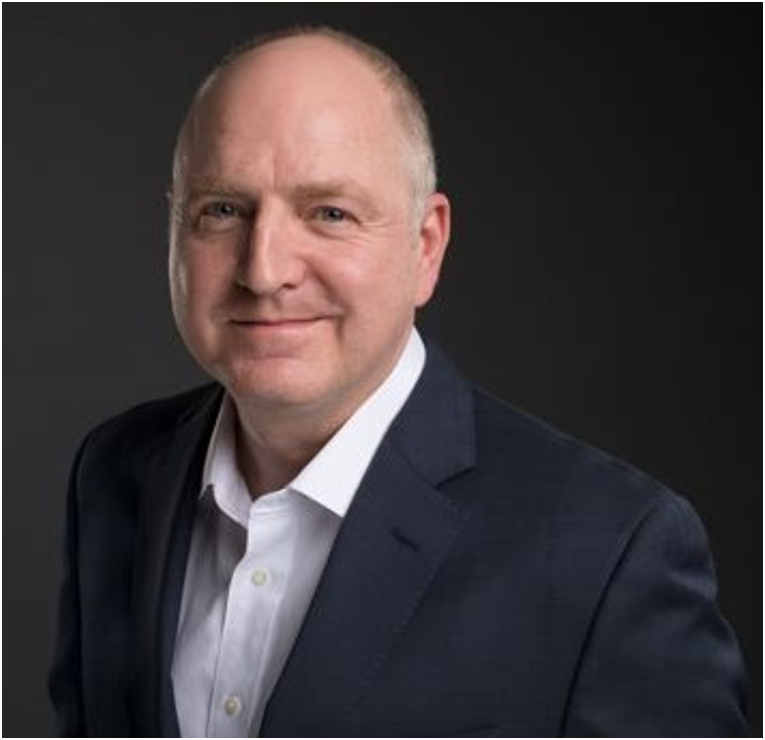
|
Denis Gaudreault, Country Manager, Intel Canada and Latin America |

|
Wayne Berger, CEO, IWG Plc |

|
Eric Wright, CEO, LexisNexis Canada |

|
Gary Davenport, past president of CIO Association” of Canada, former VP of IT, Enterprise Solutions Division, MTS AllStream |

|
Jennifer Schaeffer, VP of IT and CIO, Athabasca University |
Bibliography
Beaudan, Eric. “Do you have what it takes to be an executive?” The Globe and Mail, 9 July 2018. Web.
Bersohn, Diana. “Go Live on Day One: The Path to Success for a New CIO.” PDF document. Accenture, 2015. Web.
Bradt, George. “Executive Onboarding When Promoted From Within To Follow A Successful Leader.” Forbes, 15 Nov. 2018. Web.
“CIO Stats: Length of CIO Tenure Varies By Industry.” CIO Journal, The Wall Street Journal. 15 Feb. 2017. Web.
“Enlarging Your Sphere of Influence in Your Organization: Your Learning and Development Guide to Getting People on Side.” MindTools Corporate, 2014.
“Executive Summary.” The CIO's First 100 Days: A Toolkit. PDF document. Gartner, 2012. Web.
Forbes, Jeff. “Are You Ready for the C-Suite?” KBRS, n.d. Web.
Gallo, Carmine. “Tim Cook Uses These 5 Words to Take Control of Any Conversation.” Inc., 9 Aug. 2019. Web.
Giles, Sunnie. “The Most Important Leadership Competencies, According to Leaders Around the World.” Harvard Business Review, 15 March 2016. Web.
Godin, Seth. “Ode: How to tell a great story.” Seth's Blog. 27 April 2006. Web.
Green, Charles W. “The horizontal dimension of race: Social culture.” Hope College Blog Network, 19 Oct. 2014. Web.
Hakobyan, Hayk. “On Louis Gerstner And IBM.” Hayk Hakobyan, n.d. Web.
Bibliography
Hargrove, Robert. Your First 100 Days in a New Executive Job, edited by Susan Youngquist. Kindle Edition. Masterful Coaching Press, 2011.
Heathfield, Susan M. “Why ‘Blink’ Matters: The Power of Your First Impressions." The Balance Careers, 25 June 2019. Web.
Hillis, Rowan, and Mark O'Donnell. “How to get off to a flying start in your new job.” Odgers Berndtson, 29 Nov. 2018. Web.
Karaevli, Ayse, and Edward J. Zajac. “When Is an Outsider CEO a Good Choice?” MIT Sloan Management Review, 19 June 2012. Web.
Keizer, Gregg. “Microsoft CEO Nadella Aces First-100-Day Test.” Computerworld, 15 May 2014. Web.
Keller, Scott, and Mary Meaney. “Successfully transitioning to new leadership roles.” McKinsey & Company, May 2018. Web.
Kress, R. “Director vs. Manager: What You Need to Know to Advance to the Next Step.” Ivy Exec, 2016. Web.
Levine, Seth. “What does it mean to be an ‘executive’.” VC Adventure, 1 Feb. 2018. Web.
Lichtenwalner, Benjamin. “CIO First 90 Days.” PDF document. Modern Servant Leader, 2008. Web.
Nawaz, Sabina. “The Biggest Mistakes New Executives Make.” Harvard Business Review, 15 May 2017. Web.
Pruitt, Sarah. “Fast Facts on the 'First 100 Days.‘” History.com, 22 Aug. 2018. Web.
Rao, M.S. “An Action Plan for New CEOs During the First 100 Days.” Training, 4 Oct. 2014. Web.
Reddy, Kendra. “It turns out being a VP isn't for everyone.” Financial Post, 17 July 2012. Web.
Silcoff, Sean. “Exclusive: John Chen’s simple plan to save BlackBerry.” The Globe & Mail, 24 Feb. 2014. Web.
Bibliography
“Start Stop Continue Retrospective.” GroupMap, n.d. Web.
Surrette, Mark. “Lack of Rapport: Why Smart Leaders Fail.” KBRS, n.d. Web.
“Understanding Types of Organization – PMP Study.” Simplilearn, 4 Sept. 2019. Web.
Wahler, Cindy. “Six Behavioral Traits That Define Executive Presence.” Forbes, 2 July 2015. Web.
Watkins, Michael D. The First 90 Days, Updated and Expanded. Harvard Business Review Press, 2013.
Watkins, Michael D. “7 Ways to Set Up a New Hire for Success.” Harvard Business Review, 10 May 2019. Web.
“What does it mean to be a business executive?” Daniels College of Business, University of Denver, 12 Aug. 2014. Web.
Yeung, Ken. “Turnaround: Marissa Mayer’s first 300 days as Yahoo’s CEO.” The Next Web, 19 May 2013. Web.